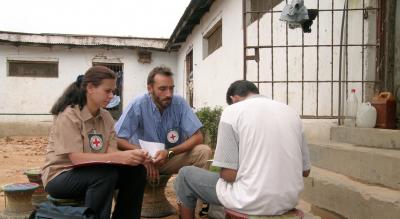Case prepared by Pierpaolo Castiglioni, Yiota Constantinidi, Fiammetta Ferioli, LL.M. students at Roma Tre University under the supervision of Giulio Bartolini (Professor) and Tommaso Natoli (Research assistant), Roma Tre University IHL Legal Clinic; with the contribution of Jemma Arman and Isabelle Gallino, LL.M. students at the Geneva Academy.
A. NEPAL FREES REBEL LEADERS
The authorities in Nepal say they have released three senior Maoists in an attempt to woo rebels back to peace talks.
The release of the three was a key condition set by the rebels in an ultimatum delivered on Monday. A government spokesman said the Maoists should now return to negotiations, which broke down in May.
The rebels' other demands include information on the whereabouts of missing comrades, and a curb on army movements.
Kamal Thapa, government negotiator and a senior minister, ruled out restricting the movement of the army or scrapping a counter-terrorism agreement with the US.
But he said that there would be no new army offensive against the rebels.
Straight talking
The three rebels released were identified as Rabindra Sheshtra, Bamdev Chhetri and Mumaram Khanal.
There has been no formal response from the rebels yet to the prisoner release.
The government wants the Maoists to resume peace talks by mid-August.
In Monday's ultimatum, chief rebel negotiator Baburam Bhattarai set July 31 as the deadline for rebel demands to be met.
[…]
Peace talks between the government and Maoist rebels broke down in May after two rounds.
A ceasefire was agreed in January as part of an attempt to resolve the seven-year conflict which has claimed at least 7,000 lives.
B. NEPAL COURT ORDERS RELEASE OF DETAINEES
Nepal’s Supreme Court ordered the royalist government Friday to release 37 political detainees who opposed the king’s rule, while communist insurgents freed two abducted officials amid a major army offensive in the southwest.
The freed politicians called the court’s ruling "a victory for democracy" and pledged to intensify their campaign against King Gyanendra, who seized power in February 2005.
Judges ruled they did not find any reason for the detentions and ordered the government to immediately free the prisoners.
The detainees freed Friday included senior members of the seven political parties that have formed an alliance to press for democracy in this Himalayan nation. Thirteen were brought to the court while the rest were released from several detention centers in the capital, Katmandu.
"This is a victory for those who believe in democracy. We will continue our struggle for democracy and immediately return to our movement," said Raghuji Pant of the Communist Party of Nepal.
Pant was arrested during a Feb. 1 police raid as the government tried to foil opposition plans to boycott and disrupt municipal elections that day.
Hundreds have been jailed since the king seized power and declared a state of emergency, saying he was acting to quell the Maoist rebellion and bring order to the country’s chaotic politics.
The rebels, who say they are inspired by Chinese revolutionary Mao Zedong, have fought for a decade to establish a communist state in Nepal.
The prisoners have been detained for terms ranging from a few days to many months.
Authorities arrested a number of politicians and activists in recent weeks in a government crackdown on protest rallies. Many were freed this past week following a series of lawsuits filed by rights groups.
C. NEPALESE REBELS FREED FROM JAIL
Nepal's government has begun releasing Maoist rebels detained under a controversial anti-terror law.
The move follows Monday's decision to withdraw charges against them and not to renew the legislation.
The law was aimed at Maoist rebels who previous governments said were terrorists.
Nepal's new government began peace talks with rebels after mass protests forced King Gyanendra to hand power to an opposition coalition in April.
'Long live the republic!'
More than 60 rebels walked free from a high-security prison in Kathmandu's suburbs, Reuters news agency reported.
They were greeted by crowds of friends and relatives carrying garlands.
[…]
Home Ministry spokesman Banan Prasad Naupani told the BBC that the prisoners - most of them lower-ranking members of the Maoist movement - were being freed from jails across the country.
He said the exact number of detainees being freed was not yet clear.
The BBC's Sushil Sharma in Kathmandu says more than 300 rebels are expected to benefit from the government move.
Their release is taking place ahead of a second round of talks which the government and rebels say will start shortly.
About 700 Maoist prisoners - including senior leaders held under other laws - were freed ahead of the first round of talks last month.
D. THE CODE OF CONDUCT FOR CEASEFIRE AGREED BETWEEN THE GOVERNMENT OF NEPAL AND THE CPN (MAOIST) ON 25 MAY 2006 AT GOKARNA
Preamble
[...]
Remaining committed towards the Universal Declaration of Human Rights 1948, and the basic principles and norms concerning international humanitarian law and human rights;
[…]
Code of Conduct as follow has been issued as per the desire of the Nepali people in order to transform the ceasefire between the Government of Nepal and the CPN (Maoists) into a permanent peace and resolve the problem peacefully through negotiations.
[...]
16. To withdraw the accusation, prosecution and cases induced against various individuals by both the parties and release the detainees gradually.
[...]
19. To return the properties that are seized, locked up or prohibited to use during the conflict, of the leaders and the workers of political parties and public -in- general, to the concerned persons or families and to allow them to consume. To resolve the problems through the mutual agreement, this may arise while returning the properties.
[...]
Discussion
I. Classification of the Situation and Applicable Law
1. How would you qualify the situation between the Maoists and the Government of Nepal? What additional information would you require in order to make such a determination? (
GC I-IV, Art. 3;
P II, Art. 1)
2. When does a non-international armed conflict end?
II. Detention in Non-International Armed Conflicts
4. In a non-international armed conflict, can persons be prosecuted by the State for their mere participation in hostilities? Is there any obligation on the State to grant an amnesty to those who participate in hostilities? (
P II, Art.6.5;
CIHL, Rule 159)
III. Elements Contributing to Respect for IHL
6. How do you evaluate the relationship between peace talks and respect for IHL in this case? Can peace talks lead to respect for IHL, and can respect for IHL lead to peace talks?
7. What might motivate a State to issue amnesties to those who participate in hostilities but who otherwise do not commit war crimes? Why would the issue of amnesties be of particular importance to non-state armed groups at the close of hostilities? How can negotiations for peace encourage the issue of amnesties?
8. What role can the judiciary play to ensure compliance with IHL in relation to detention? Why is the judiciary in principle well placed to perform this role? What are its limitations? What qualities must the judiciary have if it is to effectively perform this role?






